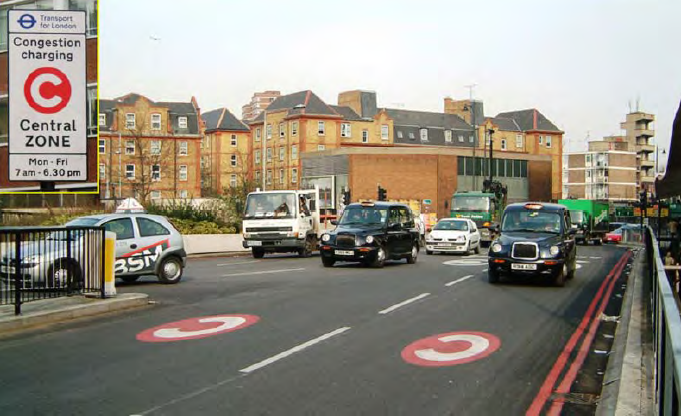
In the City Fix three researchers from WRI Ross Centre for Sustainable Cities have been examining what cities need to do to adopt TDM (Transport Demand Management) systems. And they have come up with some compelling points.
In 2002, the average London driver spent half their travel time sitting in traffic, and road transport accounted for 95 percent of fine particle pollution in the city center. To combat these problems, Greater London’s first mayor, Ken Livingstone, turned to congestion charging…. Unlike in Stockholm, where prices differ during peak and off-peak hours and tolls charge drivers every time they pass a control point, London drivers face a simple, one-time charge of £11.50 ($15.90) to enter the zone, measuring 13 square miles (21 kilometers).
Since the congestion charge introduction in 2003, pedestrian space has increased and car usage has declined. This is due to three factors~ a “centralized institutional structure and strong political will, extensive public communication and consultation, and improved public transport and fare integration.”
With 33 boroughs in London the establishment of Transport for London by Mayor Ken Livingstone established a framework to implement congestion charging. The Mayor framed less congestion as improving “economic competitiveness and livability”.
Public outreach on congestion charges was assisted with a network of people who understood the policy and supported it, and public information was readily available. “The team initiated an intensive program of advertisements, using TfL’s website, newspapers, public radio and television to educate the public about how it worked and what it would mean for residents and commuters. They addressed questions like, what is the congestion charging, how much is it, and how do you pay.” They also integrated many of the suggestions from public outreach into the design and roll out of the congestion charges.
Lastly, knowing that “the more you invest in roads, the more congestion you create” Transport for London added 300 new buses on the day the congestion charges began, rolled out the “Oyster” transit cards, and made it easy to pay fares through different applications. “The strategy was to engage both the supply and demand sides of transport simultaneously.”
Revenue from the congestion charging which is estimated to be approximately 2.5 billion in the first 15 years has been “strictly reinvested in London’s transport improvements, especially for public and non-motorized transport.”
In the first year of implementation of congestion charges private car usage fell by 30 per cent and bus usage increased by 20 per cent. Low transit fares meant a 40 per cent increase in rush hour passengers entering the congestion charge area by bus. Cycling use increased by 230 per cent since 2000. Crashes involving cyclists decreased, and carbon emissions decreased by 20 per cent.
The benefits to the city are evident. “One estimate suggests the net economic benefits of congestion charging in London’s first year of implementation reached £50 million ($78 million in 2004).
While services like Uber and delivery vans are new transport challenges, enhanced pedestrian areas and protected bike lanes claim space previously used by cars. London is now considering expanding the congestion charging zone city-wide and expanding electronic tolls to charge motorists on time of day and amount of mileage.
The newly released Mayor’s Transport Strategy now strives for an 80 per cent modal split of walkers, cyclists and transport users by 2041. In fifteen years London has demonstrated the effectiveness of congestion charges in achieving a greener, healthier city with a policy understood and embraced by its residents.
The takeaway? The need for Metro Vancouver to be strongly supported by all municipalities in congestion pricing strategies, the necessity for good public outreach, and the ramping up of better and more consistent transit service. London has shown that their road pricing model works.













It’s also equally important to frame the charge against WHAT WE ALREADY PAY for slow traffic. Driving commuters aren’t going from paying nothing to suddenly being slapped with $800/year in a congestion fee, as the current discussion goes. The choice is between continuing to pay $600/year (say) for an ever-worsening state of affairs, or $800/year for something much better.
To compare the congestion London, with its network of medieval era streets poorly adapted for vehicles, endured with Vancouver’s (the youngest major city on the this continent) is ludicrous. Whatever congestion we have now is largely due to Vision-era policies, such as allowing two of four lanes on major arterials like Seymour and Howe to be given over to vehicle storage for much of the day.